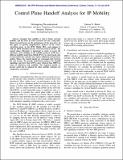Control plane handoff analysis for IP mobility
Abstract
Seamless host mobility is vital to future network mobility, and has been an active research area for a long time. Much research focuses on the performance of the data plane. In this paper, we present comprehensive analyses on the control (signalling) plane in the IETF Mobile IPv6, and compare it with the IRTF Identifier-Locator Network Protocol (ILNP). The control plane behaviour is important in order to assess the robustness and scalability of the mobility protocol. ILNP has a different mobility model from Mobile IPv6: it isa host-based, end-to-end architecture and does not require additional network-layer entities. Hence, the control signals are exchanged only between the end systems. We provide model-based analyses for handoff signalling, and show that ILNP is more efficient than MIPv6 in terms of robustness and scalability. The analytical models we present could also be adapted for other mobility solutions, for comparative assessment.
Citation
Phoomikiattisak , D & Bhatti , S N 2016 , Control plane handoff analysis for IP mobility . in 2016 9th IFIP Wireless and Mobile Networking Conference (WMNC) . IEEE , pp. 65-72 , 9th IFIP Wireless and Mobile Networking Conference - WMNC , Colmar , France , 11/07/16 . https://doi.org/10.1109/WMNC.2016.7543931 conference
Publication
2016 9th IFIP Wireless and Mobile Networking Conference (WMNC)
Type
Conference item
Collections
Items in the St Andrews Research Repository are protected by copyright, with all rights reserved, unless otherwise indicated.

